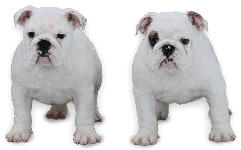"The feet should be moderate in size, compact and firmly set. Toes compact, well split up, with high knuckles and very short stubby nails. The front feet may be straight or slightly out-turned."
Interdigital cysts are fluid filled, swollen sacs between the toes, usually on the front feet. The area is sore and painful. The dog will lick or bite at the area trying to break the cyst to relieve the pressure. It can be treated in several ways.
First, you can use a tweezers to remove any ingrown hairs from the underside of the cyst. Then apply pressure to the cyst to expel any fluid you can. This will usually work quickly. If it doesn't, try bathing the foot several times a day in an Epsom salt solution until the swelling bursts. If the area is red and swollen, use a cold water solution; once the redness disappears, use a hot water solution. An antibiotic ointment, like Panalog, placed between the toes helps to prevent infection once it bursts. In severe cases, your Vet may need to inject a cortisone-related drug to reduce swelling or to cut the cyst to permit it to drain.
Be prepared; cut pads bleed profusely. It usually looks worse than it is. Be sure the wound is clean and no foreign object - glass, for example, is present. Do not use peroxide on a fresh wound and do not wipe a wound which has stopped bleeding. Both will make bleeding harder to control. Once you are sure the wound is clean, apply firm and steady pressure on the pad until the bleeding stops. This may take some time. Then bandage the foot and get the dog to the Vet as quickly as possible . Cut pads will usually heal without a trace of the injury.
As discussed elsewhere, your dogs nails will need trimming unless it is very active and on a hard surface where it naturally wears down its nails. If not trimmed frequently, the nails can grow and curve around into the skin of the feet, causing a painful condition. By establishing a regular nail trimming schedule, you can avoid this problem entirely.












